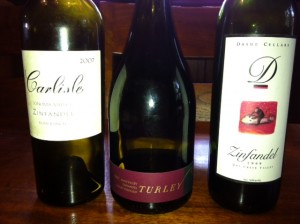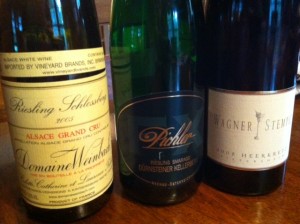Pairings of a different sort
I’ve really been into pairings lately. Not, though, of the food-wine-matchup variety.
It just has turned out that a buttload of recent gatherings have included a few of the same  varietal ““ three rieslings or zins here, two aglianicos or Brunello di Montalcinos there ““ creating an opportunity for intrigue and insight.
varietal ““ three rieslings or zins here, two aglianicos or Brunello di Montalcinos there ““ creating an opportunity for intrigue and insight.
Part of what makes wine endlessly fascinating is that even thoroughly familiar varietals can come in such divergent versions that it’s hard to believe they’re made with the same grape.
This is true at all “levels,” all price points. The less expensive wines can differ mightily in ripeness/acidity (from super-jammy to tart), body (from lithe to dense) and structure (many cheaper ones are what we call “doughnut wines,” with no midpalate/center), all within the same varietal.
A wine’s origins also can make all the difference in the, uh, world. Sauvignon blancs from New Zealand, California and France almost invariably have marked differences in aromas, flavors and textures. Same for syrah/shiraz from Australia, Washington and the Rhone. Alsatian pinot gris is decidedly different from Italian pinot grigios, save for a few bottlings from Alto Adige.
And that’s not even counting the way the same grape from the same region, especially chenin blanc from the Loire and riesling from Germany, can be crafted into fabulous wines  at every stop between bracingly dry and nectar-y sweet. (Riesling [left] and pinot noir, widely considered the most “transparent” grapes in the way they express their terroir, provide an endless array of profiles.)
at every stop between bracingly dry and nectar-y sweet. (Riesling [left] and pinot noir, widely considered the most “transparent” grapes in the way they express their terroir, provide an endless array of profiles.)
Another cool array presents itself when a battle rages in a locale such as Piedmont or Portugal between traditional and modern philosophies, or somewhere in between.
All of this creates a win-win situation for wine enthusiasts. You can get together with friends and try different bottles of the same varietal and figure out which style you prefer, and argue or pontificate about them. Or you can skip that last part, and just enjoy ’em.
In the zins pictured above, for instance, the Dashe showed berries and earth before getting raisiny at the end; the Carlisle was a knockout with delicious, darker red fruit and much more oomph in the midpalate and finish, and the Turley came on strong with the minerally texture and blue and black fruit.
The best news is, you don’t have to choose a favorite, especially if you’re “easy” like me. I liked ’em all. A lot.



